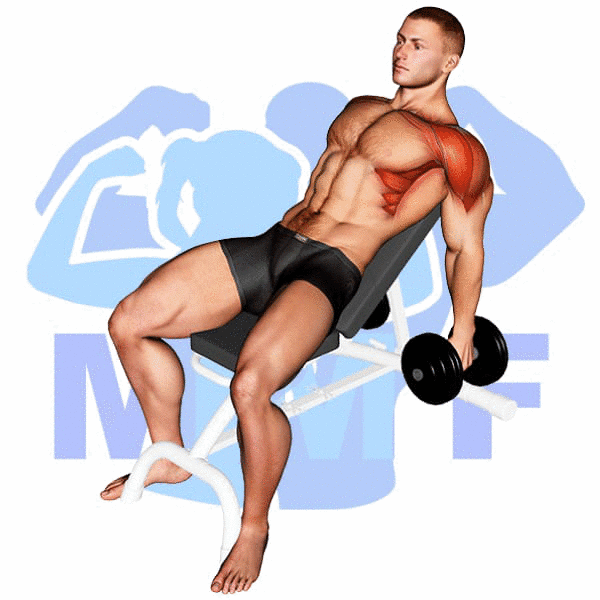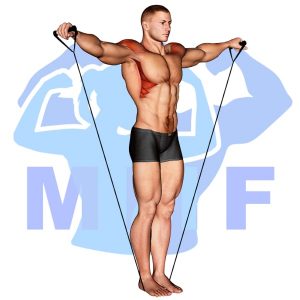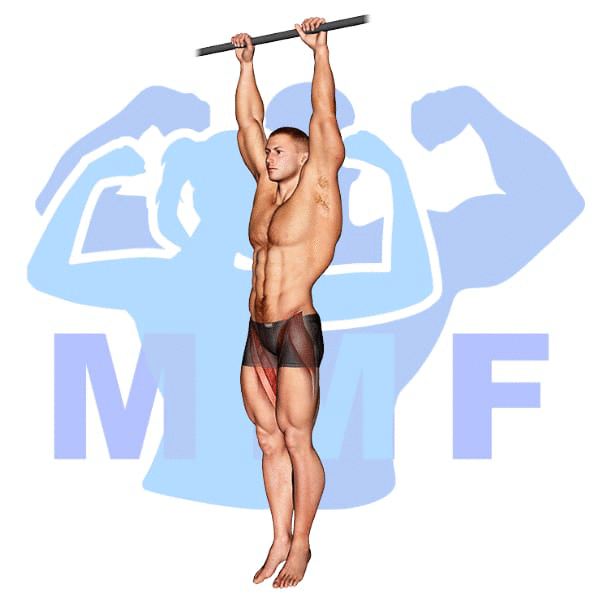Are you struggling to build your shoulder muscles despite religiously doing your incline dumbbell raises? You’re not alone. Many people think that doing this exercise alone is enough to increase their shoulder strength and mass, but unfortunately, it’s not that simple. The good news is, the reason behind your stagnant shoulder growth is likely to be one of the common causes, such as poor form or improper weight selection. In this post, we’ll be sharing tips and tricks on how to properly execute an incline dumbbell raise for maximum shoulder growth. With the right technique and mindset, you’ll be able to achieve the shoulders you’ve always wanted.
Incline Dumbbell Raise Summary
- Primary Muscles: Deltoid – Lateral
- Secondary Muscles: Deltoid – Anterior, Serratus Anterior, Supraspinatus, Trapezius – Lower, and Trapezius – Middle
- Equipment: Dumbbells and Incline Bench
- Mechanics Type: Isolation
- Force: Push
- Utility: Auxiliary

Incline Dumbbell Raise Instructions
- You will commence by choosing dumbbells that you can lift with keeping your arms straight, then lay down on a incline bench with your back to the bench.
- Start with your arms hanging toward the ground with a dumbbell in each hand.
- Next, lift the dumbbells up in front of you keeping your arms straight until they are parallel with the ground.
- After a brief pause, lower the dumbbells back down to the hanging position.
- Continue to repeat completing your desired number of repetitions.
Video Tutorial
Incline Dumbbell Raise Muscles
Target (Agonist)
Synergists
Dynamic Stabilizers
- None
Stabilizers
- Levator Scapulae
- Trapezius – Upper
- Wrist Extensors
Antagonist Stabilizers
- None

Benefits of Incline Dumbbell Raise
The Incline Dumbbell Raise is an excellent exercise to include in a strength training routine, especially for the Deltoid – Lateral. This exercise allows you to precisely target the lateral head of the deltoid muscle, which is responsible for shoulder abduction and external rotation. The incline angle also increases the range of motion and involves more of the lower trapezius, allowing you to maximize the amount of muscle fiber recruitment. Additionally, due to its unilateral nature, it helps to improve muscular imbalances between sides and increases shoulder stability. In short, it is an effective and efficient exercise that can be used to improve shoulder strength and stability.
Tips for Performing Incline Dumbbell Raise
When you need to get the highest quality results, you will need to abide by these simple and easy tips. Most Importantly, in case you need to thwart the probability of an injury, you must use these tips.
- Plan Your Workout Before You Get To The Gym. Make sure you arrange your training in advance when you have a target. If perhaps your objective is simply to maintain, you should still have a plan when you start training.
- Slow Every Rep Down For Superior Muscle Hypertrophy. By Raising the time under tension you are exercising your muscles more and they will respond by developing toned muscles. You can achieve this without increasing the weight by slowing down you reps about 4 – 6 seconds constriction and pause then 4 – 6 seconds expanding.
- Slow Down Every Rep To 4-6 Seconds Per Contraction And The Same For The Extension, To Boost Your Exercise Session. To develop mas you need to increase the time under strain of your primary muscle tissue. Slowing down your lift will boost time under strain. Frequent studies have shown that 4-6 seconds extension and contraction is the ideal time provides maximal benefit for creating muscle mass. You should include this approach occasionally, and not anytime you workout.
- Lift In A Place Where You Are Able To Analyze Your Form In A Mirror. You need to be able to always maintain solid technique on every repetition, so you can accomplish that you have to be able to to watch and fix your technique.
Benefits and Tips Video
Frequent Mistakes To Avoid
You should stop these very common issues to ensure great technique and see large gains. Also, when you steer clear of these problems you will minimize the possibility of receiving injuries.
- Stop Yourself From Using To Little or Too Much Resistance. Not enough, and you will not be effecting your primary muscles, excessive, and you will likely need to cheat. Ensure you focus on your form.
- Try Not To employ poor technique. Poor form can be the fast way to have a physical injury.
- Don’t Cut A Warmup. getting the blood flowing to your Muslces is the Best way to prevent personal injury.
Find More Dumbbell Exercises Here
Variations and Complementary Exercises
If you are looking for exercises to supplement or replace Incline Dumbbell Raise, consider the following variations, complementary, or alternative exercises. Each exercise works similar muscles to Incline Dumbbell Raise and will help build strength and stability.
Incline Dumbbell Rear Lateral Raise

The Incline Dumbbell Rear Lateral Raise is a great complementary or alternative exercise to the Incline Dumbbell Raise. This exercise targets the rear deltoid muscles and helps to improve shoulder stability. It can be performed by sitting on an incline bench with a pair of dumbbells in each hand. Begin by lifting the dumbbells out to the sides of the body, keeping your elbows slightly bent and your palms facing down. Slowly lower the weights back to the starting position and repeat for desired reps. This exercise is great for strengthening and building the rear delts, which can help to create a balanced shoulder development.
Incline Dumbbell Rotating Lateral Raise

The Incline Dumbbell Rotating Lateral Raise is a great complement to the Incline Dumbbell Raise. It works the same muscles but with a different angle. The Incline Dumbbell Rotating Lateral Raise targets the side deltoids, which are often neglected in traditional shoulder exercises. The exercise also helps to open up the shoulder joint and increase its range of motion. This exercise is perfect for athletes looking to increase shoulder stability, strength and mobility. It is also an ideal alternative exercise for those who find the Incline Dumbbell Raise too challenging.
Incline Dumbbell Single Arm Rear Lateral Raise

The Incline Dumbbell Single Arm Rear Lateral Raise is an excellent exercise to supplement or even replace the Incline Dumbbell Raise. This exercise targets the rear deltoids, which are often overlooked when performing the regular Incline Dumbbell Raise. This exercise also helps to improve balance and stability in the shoulder joint by forcing the lifter to lift with one arm at a time. Additionally, this exercise can be performed in a seated or standing position, allowing for more variation in your workout.
Check Out These Top Dumbbell Exercises
Lateral Raises With Bands

Lateral Raises With Bands is a great alternative or complementary exercise to the Incline Dumbbell Raise. This exercise works the same muscles as the Incline Dumbbell Raise, but instead of using dumbbells, you use resistance bands. The advantage of this exercise is that it allows you to control the amount of tension you are using, making it easier to find a weight that is right for you. Additionally, it helps to engage your stabilizer muscles and build functional strength. To perform this exercise, stand with your feet shoulder-width apart and hold the band in both hands at your side. Keeping your elbows slightly bent, raise your arms out to the side until they reach shoulder height. Pause for a second and then slowly lower your arms back to the starting position.
Lever Lateral Raise (Machine)

The Lever Lateral Raise (Machine) is a great alternative or complementary exercise to the Incline Dumbbell Raise. This exercise targets the lateral deltoid muscles, which are often neglected during shoulder exercises. By using a lever machine, it allows for more control and stability during the exercise. It also eliminates the need for a spotter, making it a great option for those training solo. The Lever Lateral Raise is a great addition to any shoulder routine as it helps to build strength and size in the lateral deltoid muscles.
Lying Dumbbell Rear Lateral Raise

The Lying Dumbbell Rear Lateral Raise is a great complementary or alternative exercise to the Incline Dumbbell Raise. This exercise involves lying on your back on a flat surface, holding a dumbbell in each hand and raising the weights out to the sides. This exercise targets the rear deltoids and helps build strength in the shoulder area. It can be done as a unilateral exercise, alternating arms, or as a bilateral exercise, lifting both arms at the same time. It is important to keep the core engaged and the back flat while performing this exercise to ensure proper form and prevent injury. This exercise can help develop shoulder strength and stability for athletes, bodybuilders, and those looking to improve their overall fitness.
Find More Shoulders Exercises Here
Opposing Complementary Exercises
It is important to choose exercises that work opposing muscle groups in order to balance the body and prevent injury. To further complement the exercise Incline Dumbbell Raise, add the following exercises to your routine:
Barbell Wide Bench Press

The Barbell Wide Bench Press is a great complement to the Incline Dumbbell Raise as it works the opposite muscle group. This exercise targets the chest, triceps, and shoulders, and helps to build strength and power in these areas. It also helps to improve stability and balance as it requires you to press from a wider range of motion than the Incline Dumbbell Raise. By working opposing muscle groups, you can effectively develop overall upper body strength. Furthermore, the Barbell Wide Bench Press can help to increase muscle mass and improve performance in other exercises.
Dumbbell Bench Press

The Dumbbell Bench Press is a great exercise to pair with the Incline Dumbbell Raise. It works the opposing muscle group of the chest and is complementary to the Incline Dumbbell Raise. By doing both exercises, you are able to target both the upper and lower chest muscles. The Dumbbell Bench Press works the pectoralis major and minor muscles, as well as the triceps, while the Incline Dumbbell Raise works the anterior deltoids and trapezius muscles. Together, these two exercises create a balanced workout that provides an effective way to strengthen and tone your chest.
Decline Dumbbell Bench Press

The Decline Dumbbell Bench Press is an exercise that is complementary to the Incline Dumbbell Raise in that it works the opposing muscle groups. This exercise is performed by lying on a decline bench, holding a dumbbell in each hand, and then pushing the weights up and down while keeping your arms straight. The Decline Dumbbell Bench Press works the lower chest and triceps muscles, while the Incline Dumbbell Raise works the upper chest and shoulders. By combining both exercises, you will be able to target all areas of your chest and arms for a well-rounded workout.
Boost Your Shoulder Workout with Incline Dumbbell Raises
If you’re looking to take your shoulder workout to the next level, consider incorporating incline dumbbell raises. This exercise targets your anterior deltoids, which are responsible for lifting your arms to the front and overhead. By performing this exercise on an incline bench, you can isolate the anterior deltoids and increase their recruitment for a more effective workout. Be sure to start with a light weight and focus on proper form, lifting the dumbbells to shoulder height and fully extending your arms at the top of the movement. With consistent practice, you’ll start to see improvements in your shoulder strength and definition.
References: Wikipedia | ExRx.net | PubMed.gov | Comprehensive List of Shoulders Dumbbell Exercises




